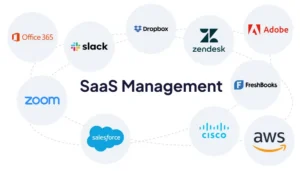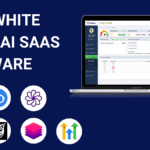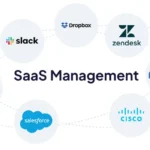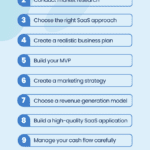SaaS Management is the process of managing and optimizing Software as a Service applications within an organization. It involves monitoring usage, costs, and compliance.
SaaS Management helps businesses streamline their software usage. Organizations often use multiple SaaS applications, leading to challenges in tracking and optimizing them. Effective SaaS Management ensures cost efficiency, enhances productivity, and maintains compliance with various regulations. It involves tasks like license management, usage monitoring, and integration of different SaaS tools.
Businesses benefit from a centralized approach, avoiding unnecessary expenses and improving overall software performance. SaaS Management tools provide insights and automate many processes, making it easier for IT teams to handle software needs. This leads to better decision-making and resource allocation.
Introduction To Saas Management
Software as a Service (SaaS) has revolutionized the way businesses operate. SaaS Management ensures the efficient use of these cloud-based tools. It involves overseeing SaaS applications to maximize their value.
Rise Of Saas Solutions
In recent years, SaaS solutions have seen tremendous growth. Businesses adopt SaaS for its flexibility and cost-effectiveness. SaaS applications are accessible from anywhere with internet access.
Several factors contribute to the rise of SaaS solutions:
- Cost Savings: No need for expensive hardware or software maintenance.
- Scalability: Easily scale up or down based on business needs.
- Accessibility: Access applications from any device, any location.
- Automatic Updates: Always have the latest features without manual updates.
More businesses now rely on SaaS for their day-to-day operations.
Importance Of Effective Management
Effective management of SaaS applications is crucial. Without proper management, businesses may face several challenges. These include:
- Security Risks: Unmanaged applications can pose security threats.
- Cost Overruns: Hidden costs can accumulate without proper oversight.
- Redundant Tools: Multiple tools serving the same purpose increase costs.
- Compliance Issues: Unmanaged SaaS can lead to regulatory non-compliance.
Proper SaaS management helps mitigate these risks. It involves several key practices:
- Inventory Management: Keep track of all SaaS applications in use.
- Access Control: Ensure only authorized users access the tools.
- Cost Monitoring: Regularly review SaaS spending to identify savings.
- Compliance Checks: Ensure all SaaS tools comply with industry regulations.
Implementing these practices can lead to more efficient and secure operations.

Credit: www.cledara.com
Key Features Of Saas Management Platforms
Managing SaaS applications can be overwhelming. SaaS Management Platforms help businesses control their software environment. These platforms offer several key features to streamline operations. Here are the crucial features you should know:
Centralized Visibility
Centralized visibility gives a unified view of all SaaS applications. This feature allows tracking of usage, licenses, and costs. Businesses can identify redundant applications. It helps in optimizing software expenses and usage.
| Feature | Benefit |
|---|---|
| Unified Dashboard | View all applications in one place |
| Usage Tracking | Monitor software usage effectively |
| Cost Management | Identify and reduce redundant costs |
Automated Workflows
Automated workflows save time by eliminating manual tasks. They streamline onboarding and offboarding processes. Automated workflows ensure compliance and reduce errors.
- Onboarding New Users
- Offboarding Exiting Employees
- License Allocation and Deallocation
Integration Capabilities
Integration capabilities allow seamless interaction with other tools. These capabilities ensure data flows between different systems. They enhance productivity and data accuracy.
- API Integrations
- Third-party App Support
- Customizable Connectors
Understanding these key features can help in choosing the right SaaS Management Platform. These features ensure efficient and cost-effective software management.
Benefits Of Streamlining Saas Tech
Streamlining SaaS tech offers numerous advantages. Businesses can achieve cost savings, enhanced security, and improved compliance. Let's explore these benefits in detail.
Cost Savings
By managing SaaS applications efficiently, companies can cut costs significantly. Subscription costs can be optimized by eliminating unused licenses. Automated processes reduce the need for manual intervention, saving time and resources. Streamlined SaaS tech also minimizes the risk of costly errors.
Enhanced Security
Centralized management of SaaS applications enhances security measures. It ensures consistent application of security protocols across all platforms. Automated updates prevent vulnerabilities and reduce security risks. Central monitoring helps detect and address threats promptly.
Improved Compliance
Effective SaaS management ensures adherence to regulatory requirements. It simplifies tracking and reporting of compliance data. Automated compliance checks reduce the risk of non-compliance. Businesses can avoid fines and legal issues with proper SaaS management.
Challenges In Saas Management
Managing SaaS applications can be complex and challenging. SaaS (Software as a Service) offers many benefits but also presents unique hurdles. Below are some common challenges faced in SaaS management.
Subscription Overload
Companies often subscribe to many SaaS applications. This can lead to subscription overload. Managing multiple subscriptions can be daunting. Tracking usage and costs becomes difficult. Duplicate subscriptions might occur, wasting resources.
| Issue | Impact |
|---|---|
| Too many subscriptions | Hard to manage |
| Duplicate subscriptions | Wasted resources |
Data Silos
Data silos occur when data is isolated in different systems. This makes it hard to get a unified view of the data. Data silos can lead to inconsistent information. Collaboration between teams becomes difficult.
- Isolated data
- Inconsistent information
- Difficulty in collaboration
Access Control Issues
Access control is crucial in SaaS management. Managing who has access to what can be tricky. Too much access can lead to security risks. Too little access can hinder productivity. Proper access management ensures data security and compliance.
- Security risks from too much access
- Hindered productivity from too little access
- Need for balanced access control
Best Practices In Saas Management
Effective SaaS management is essential for optimizing software usage and costs. Implementing best practices ensures streamlined operations and enhanced productivity. This section covers key practices in SaaS management.
Regular Audits
Conduct regular audits to track SaaS usage and expenses. Audits help identify unused or underused subscriptions. They also uncover duplicate tools that can be consolidated. Regular audits ensure you are not overspending on SaaS solutions.
Create an audit schedule. Monthly or quarterly audits work well. Document findings in a table:
| Tool Name | Usage Frequency | Cost | Action Required |
|---|---|---|---|
| Tool A | Low | $50/month | Cancel |
| Tool B | High | $200/month | Keep |
User Training And Adoption
User training is vital for maximizing SaaS benefits. Proper training ensures that employees use the tools efficiently. Create easy-to-follow training materials. Use short videos, manuals, or live sessions.
Encourage user adoption by demonstrating the value of the tools. Show how the software can make tasks easier and faster. Regularly update training materials to reflect new features or changes.
Choosing The Right Tools
Selecting the right tools is crucial. Choose SaaS solutions that align with your business goals. Consider the following factors:
- Cost-effectiveness
- Scalability
- Integration capabilities
- Security features
Evaluate multiple options before making a decision. Use comparison tables to weigh pros and cons:
| Feature | Tool X | Tool Y |
|---|---|---|
| Cost | $100/month | $80/month |
| Scalability | High | Medium |
Choosing the right tools ensures seamless integration and optimal performance.

Credit: www.beamy.io
Evaluating Saas Management Tools
Evaluating SaaS management tools is crucial for businesses of all sizes. The right tool can help manage subscriptions, costs, and security. It enhances productivity and streamlines operations.
Feature Checklist
Consider these essential features when evaluating SaaS management tools:
- Subscription Management: Track and manage all subscriptions.
- Cost Optimization: Identify and eliminate unused licenses.
- Integration Capabilities: Seamlessly integrate with existing systems.
- Analytics and Reporting: Provide insights into usage and costs.
Security Standards
Security is a top priority for SaaS management tools. Here are key security standards:
- Data Encryption: Ensure all data is encrypted during transmission.
- Compliance: Adhere to industry standards like GDPR and HIPAA.
- User Authentication: Implement multi-factor authentication (MFA).
- Access Controls: Define and manage user access levels.
User Experience
A good user experience can make or break a SaaS management tool. Consider these factors:
- Intuitive Interface: Easy to navigate and use.
- Customization: Allow users to tailor the tool to their needs.
- Support and Training: Provide comprehensive support and training resources.
- Mobile Access: Access the tool from any device.
| Feature | Description |
|---|---|
| Subscription Management | Track and manage all subscriptions. |
| Cost Optimization | Identify and eliminate unused licenses. |
| Integration Capabilities | Seamlessly integrate with existing systems. |
| Analytics and Reporting | Provide insights into usage and costs. |
The Future Of Saas Management
The world of SaaS Management is evolving rapidly. The future holds exciting advancements. These advancements aim to simplify processes and boost efficiency. Companies must prepare for these upcoming changes.
Ai And Machine Learning Integration
AI and Machine Learning are transforming SaaS Management. These technologies automate repetitive tasks. They also provide smart insights and predictions. AI can detect anomalies in real-time, ensuring smooth operations.
Machine Learning helps in understanding user behavior. This understanding leads to personalized experiences. Companies can use this data to improve their services.
Predictive Analytics
Predictive Analytics is crucial for future SaaS Management. It uses historical data to predict future trends. This allows companies to make informed decisions.
Here are some benefits of Predictive Analytics:
- Better resource allocation
- Improved customer satisfaction
- Reduced operational costs
Predictive Analytics helps in forecasting demand. This ensures that resources are always available when needed.
Customization Trends
Customization is becoming a key trend in SaaS Management. Companies are offering more personalized solutions. These solutions cater to the specific needs of each user.
Here are some popular customization trends:
- User-specific dashboards
- Tailored notifications
- Custom reporting features
These trends help in enhancing the user experience. They also improve user engagement and satisfaction.

Credit: zylo.com
Case Studies: Successful Saas Management
Successful SaaS management can transform businesses of all sizes. From small businesses to large enterprises, effective SaaS management streamlines operations, enhances productivity, and reduces costs. Here, we explore real-world case studies that highlight the impact of well-executed SaaS management strategies.
Small Business Transformation
A small marketing agency adopted a SaaS management tool. This tool helped them streamline their subscription services. They had been struggling with multiple subscriptions and renewal dates.
After implementing the SaaS management tool, they saw a 30% reduction in software costs. They also improved team collaboration by centralizing all tools. This led to a 20% increase in project completion rates.
Key benefits:
- 30% reduction in software costs
- 20% increase in project completion rates
- Improved team collaboration
Enterprise-level Efficiency
A large manufacturing company faced challenges with software compliance. They had multiple departments using different SaaS solutions. This led to compliance issues and high costs.
By adopting a comprehensive SaaS management platform, they could track all subscriptions. They also ensured compliance across departments. This resulted in a 40% decrease in compliance issues. They also saved 15% on software costs.
Key benefits:
- 40% decrease in compliance issues
- 15% cost savings
- Enhanced software tracking
Startup Agility
A tech startup needed to scale quickly. They required efficient management of their SaaS tools. They adopted a SaaS management solution to gain better control.
This solution helped them allocate resources effectively. They reduced unnecessary subscriptions and optimized their SaaS usage. As a result, they saw a 25% boost in operational efficiency.
Key benefits:
- 25% boost in operational efficiency
- Better resource allocation
- Optimized SaaS usage
Frequently Asked Questions
What Is Saas In Simple Terms?
SaaS stands for Software as a Service. It delivers software applications over the internet. Users access it via web browsers, reducing the need for installations. SaaS is cost-effective and scalable, ideal for businesses of all sizes. It also includes automatic updates, enhancing user convenience and productivity.
What Does A Saas Manager Do?
A SaaS manager oversees software-as-a-service products. They manage subscriptions, user accounts, updates, and customer support. They ensure software reliability and performance. They also analyze usage data and implement improvements.
What Is Saas Management System?
A SaaS management system oversees and optimizes software-as-a-service applications. It ensures compliance, enhances security, and controls costs effectively.
What Is Saas User Management?
SaaS user management involves controlling access, permissions, and roles for users in a cloud-based software application. It ensures security and efficient administration.
Conclusion
Mastering SaaS management is crucial for optimizing your software usage. It enhances efficiency, reduces costs, and ensures compliance. By adopting effective strategies, businesses can streamline operations and improve productivity. Stay informed and proactive to fully leverage the benefits of SaaS management.
Embrace these practices for a more organized and efficient software ecosystem.






